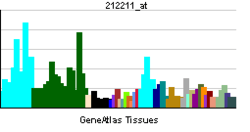ANKRD17
| View/Edit Human | View/Edit Mouse |
Ankyrin repeat domain-containing protein 17 is a protein that in humans is encoded by the ANKRD17 gene.[3][4]
This gene encodes a protein with ankyrin repeats, which are associated with protein-protein interactions. Studies in mice suggest that this protein is involved in liver development. Two transcript variants encoding different isoforms have been found for this gene.[4]
References
- ↑ "Human PubMed Reference:".
- ↑ "Mouse PubMed Reference:".
- ↑ Watt AJ, Jones EA, Ure JM, Peddie D, Wilson DI, Forrester LM (Feb 2001). "A gene trap integration provides an early in situ marker for hepatic specification of the foregut endoderm". Mech Dev. 100 (2): 205–15. doi:10.1016/S0925-4773(00)00530-X. PMID 11165478.
- 1 2 "Entrez Gene: ANKRD17 ankyrin repeat domain 17".
Further reading
- Bonaldo MF, Lennon G, Soares MB (1997). "Normalization and subtraction: two approaches to facilitate gene discovery.". Genome Res. 6 (9): 791–806. doi:10.1101/gr.6.9.791. PMID 8889548.
- Ishikawa K, Nagase T, Suyama M, et al. (1998). "Prediction of the coding sequences of unidentified human genes. X. The complete sequences of 100 new cDNA clones from brain which can code for large proteins in vitro.". DNA Res. 5 (3): 169–76. doi:10.1093/dnares/5.3.169. PMID 9734811.
- Jones EA, Tosh D, Wilson DI, et al. (2002). "Hepatic differentiation of murine embryonic stem cells.". Exp. Cell Res. 272 (1): 15–22. doi:10.1006/excr.2001.5396. PMID 11740861.
- Strausberg RL, Feingold EA, Grouse LH, et al. (2003). "Generation and initial analysis of more than 15,000 full-length human and mouse cDNA sequences.". Proc. Natl. Acad. Sci. U.S.A. 99 (26): 16899–903. doi:10.1073/pnas.242603899. PMC 139241
 . PMID 12477932.
. PMID 12477932. - Scanlan MJ, Gout I, Gordon CM, et al. (2003). "Humoral immunity to human breast cancer: antigen definition and quantitative analysis of mRNA expression.". Cancer Immun. 1: 4. PMID 12747765.
- Poulin F, Brueschke A, Sonenberg N (2004). "Gene fusion and overlapping reading frames in the mammalian genes for 4E-BP3 and MASK.". J. Biol. Chem. 278 (52): 52290–7. doi:10.1074/jbc.M310761200. PMID 14557257.
- Ota T, Suzuki Y, Nishikawa T, et al. (2004). "Complete sequencing and characterization of 21,243 full-length human cDNAs.". Nat. Genet. 36 (1): 40–5. doi:10.1038/ng1285. PMID 14702039.
- Bouwmeester T, Bauch A, Ruffner H, et al. (2004). "A physical and functional map of the human TNF-alpha/NF-kappa B signal transduction pathway.". Nat. Cell Biol. 6 (2): 97–105. doi:10.1038/ncb1086. PMID 14743216.
- Beausoleil SA, Jedrychowski M, Schwartz D, et al. (2004). "Large-scale characterization of HeLa cell nuclear phosphoproteins.". Proc. Natl. Acad. Sci. U.S.A. 101 (33): 12130–5. doi:10.1073/pnas.0404720101. PMC 514446
 . PMID 15302935.
. PMID 15302935.
This article is issued from Wikipedia - version of the 5/19/2016. The text is available under the Creative Commons Attribution/Share Alike but additional terms may apply for the media files.
